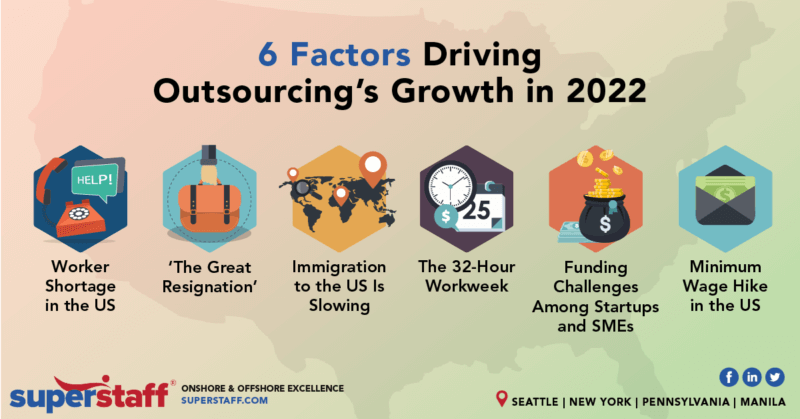
Is the outsourcing industry growing? The answer is a straightforward “yes.” Outsourcing growth has been tremendous these past few years. In 2021, the global outsourcing market was valued at $245.91 billion.
As the United States and the rest of the world reemerge from the pandemic, outsourcing will continue to make tidal impacts across industries. The global BPO industry is expected to grow up to $405.6 billion by 2027, at a CAGR of 8.0%.
This article will look into triggers propelling outsourcing growth in 2022. But first, let’s take a quick look at how big the outsourcing industry is in the U.S.
Interesting Statistics in Outsourcing:
- More than a third of small businesses outsource various functions.
- 68% of large consumer product companies in the U.S. outsource a portion of their workforce.
- Among the most commonly outsourced tasks are accounting (37%), information technology (37%), and digital marketing (34%).
What Industries Outsource the Most?
- Information Technology – The global IT outsourcing market is expected to be worth $397.6 billion by 2025.
- Financial Services – About 71% of financial service executives outsource certain functions.
- Customer Service – The value of the customer experience market is expected to reach $81.5 billion by 2023.
- Retail – About 70% of retailers and manufacturers outsource specific services.
- Healthcare – Prompted by the increase in telehealth demand, the global healthcare outsourcing sector will reach $229.2 billion by 2025.
Read more: Top 5 US Companies That Found Success Through Outsourcing Services in the Philippines
6 Significant Events Driving Outsourcing Growth in 2022
#1: Worker Shortage in the US
The high demand for talent in the U.S. far exceeds the supply. In November 2021, more than half a million jobs became available, yet the labor shortage persists. Some of the factors that contributed to the vast talent gap are the following:
The ‘Great Retirement’ of Baby-Boomers
For the longest time, employees born between 1946 to 1964 have represented the largest fraction of the working population. Their retirement from the workforce is widely felt across industries.
In 2019, about 34 million members of the Silent Generation retired from the workforce. Another 30 million baby boomer retirees followed in the third quarter of 2020. This trend meant that about 10,000 members turn 65 daily and enter their golden years. Analysts foresee this rate to remain constant until 2030.
Record-Low Participation Rates Among the Working-Age Population
Amid the recession-free decade, the U.S. has seen a steep decline in labor force participation. After reaching its peak at the turn of the 21st century, the population of the country’s workers has shrunk consistently. The national labor force participation rate has dipped from 64.4% in 2010 to 63.6% in 2019.
Among the reasons for the downward trend are:
- The dramatic change in the U.S. population’s age distribution
- The continuous rise of the cost of child care
- An increasing number of people dissatisfied with the prevailing wage rate
The Lowest Birth Rates in the U.S.
In 2020, the U.S. saw its birth rate declined for the sixth consecutive year. The country also recorded the lowest number of newborns since 1979, following a 4% decrease. Low birth rates are supposed to impact a country’s economy positively. However, this will only be the case if a larger share of the population is comprised of the working age.
#2: ‘The Great Resignation’
In recent years, the U.S. has seen many record highs and lows. But perhaps the most significant trend causing ripple effects across other economic activities is the record-high number of resignations in the country.
In 2021, a record-high number of employees in the U.S. voluntarily quit their jobs. The recent data shows that in the last business days of November 2021:
- 4.5 million workers resigned
- 10.6 million jobs opened
- Only 6.7 million employees were hired
Will the Acute Talent Shortage Drive the BPO Industry’s Growth?
Economists foresee the talent shortage to persist for years, even permanently. For this reason, many believe that more U.S. companies will turn to outsourcing for growth. Even before COVID, U.S. businesses have been relying on offshore outsourcing to address the gap in labor supply and demand. As there is still a massive surplus of skilled global talents in known outsourcing destinations like the Philippines, outsourcing will likely grow further in the future.
#3: Immigration to the US Is Slowing
For decades, immigration has played a significant role in the economic vibrancy of the U.S. International migration activities have helped offset birth rate decline, augment the country’s labor force growth, and catalyze the development of various regions. Recent data, however, show a considerable decrease in the country’s immigrant population.
A report from the U.S. Census Bureau showed that the country averaged only about 200,000 net international migration annually from 2017 to 2019, about 450,000 short of the yearly average of 650,000 from 2010 to 2017. The steep decline in immigration threatens to hamper the country’s economic recovery. According to 91% of state and local chambers of commerce, the labor gap is holding economies back.
To address the issue, the U.S. Chamber of Commerce launched the “America Works Initiative,” a campaign aiming to grow the country’s workforce. Among the call to actions is to increase employment-based immigration.
Apart from seeking immigrant workers, employers respond to the call by tapping a wider pool of talents available offshore through outsourcing initiatives. More than 93% of businesses have adopted or are considering adopting cloud solutions to strengthen outsourcing efforts.

#4: The 32-Hour Workweek
Another reason to believe outsourcing will grow in the future is the possible standardization of the 32-hour workweek. Amid the clamor to give workers a more balanced lifestyle, progressives in Congress are backing the reduction of the current national workweek standard from 40 hours to 32. Certain employees who exceed the 32 hours will be entitled to overtime pay.
While this 32-hour workweek appeals to top talent and possibly curb “The Great Resignation,” it poses numerous downsides for organizations. Among these is the possible decline in the level of customer service since fewer hours means less availability of support for customers. The overtime pay mandate could also deplete the financial resources of the companies.
Despite the downsides, there are also many benefits that businesses can get from shortening work hours. It teaches employees to find ways to be more productive and increases engagement and positivity.
The key is for businesses to balance things out to achieve the best possible outcome. One way to accomplish this is to help onshore employees maximize their work hours by outsourcing non-core activities offshore. This insight from a Forbes article explains why startups and SMEs should consider embracing outsourcing for growth:
“One important lesson learned by many companies during the pandemic was to focus on what they do best and to bring in experts when specific solutions are needed.”
#5: Funding Challenges Among Startups and SMEs
During the onslaught of the pandemic, many businesses realized the efficiency and significant cost advantage of outsourcing offshore. Supply chain challenges increased customer service demand, prompting SMEs to outsource customer support solutions. Today, the strategy proves to be even more vital.
As businesses worldwide grapple with reemerging from the impacts of the pandemic, changes are unfolding at an unprecedented speed. The need to innovate and pivot faster is more important than ever. However, many startups and small businesses lack the resources to scale rapidly. According to a survey conducted by AIN, 85% of startups are having difficulties raising investments.
Outsourcing Among Startups: One of the Biggest Future Trends in Outsourcing
Business analysts foresee that many startups and SMEs will embrace outsourcing. The strategy has enabled businesses of all sizes to reduce costs, enhance agility, and improve service quality. In addition to customer service, outsourcing’s growth will further be seen in marketing, human resources, and accounting.
#6: Minimum Wage Hike in the US
Primarily prompted by stiff competition for talents and high turnover rates, wages and compensations in the U.S. ascend. More than 80 states, cities, and counties have increased their minimum wage this year, recording the highest uptick in more than a decade. For employers, the wage hike means an average of 3.9% increase in payroll costs.
There will likely be a sharp increase in businesses that will engage a third-party service provider offshore to offset the additional payroll costs and maintain profitability. Cost reduction has always been among the significant benefit enjoyed by businesses that outsource. According to a Deloitte survey, cost advantage is the main reason why 70% of companies outsource business functions.
Will Outsourcing Grow in the Future?
The offshore outsourcing sector has become among the solid pillars of the modern U.S. economy. From the Great Recession of 2008 to the recent global health crisis, outsourcing has helped many businesses weather economic downturn—some even thrived.
As the U.S. and the rest of the world enter an era where changes, innovation, and adaption will be permanent, we have reasons to believe outsourcing will grow in the future. In fact, some countries specializing in providing outsourcing solutions have already seen an upward trend in their BPO sector’s growth.
Bigger-Than-Expected Philippine BPO Industry Growth
The Philippines has always been America’s preferred outsourcing partner. Today, amid the unstable labor market and wage hike concerns, the U.S. continues to recognize the Asian country’s contribution to the stabilization and expansion of the U.S. economy. Proof of this is the continued growth of the outsourcing industry in the Philippines.
The country’s BPO outsourcing receipts grew by 8.3% during the first nine months of 2021, exceeding the earlier projection of 5% and surpassing the forecasted performance for the entire 2021. Indeed, the Philippines remain the top outsourcing partner of choice among U.S. businesses that want to thrive amid unprecedented challenges and disruptions.
Read more: 10 Reasons Why US Companies Outsource Customer Service to the Philippines
Choose Your Ideal Outsourcing and Growth Partner in the Philippines
SuperStaff is a forward-thinking company that has been instrumental in ensuring the growth of numerous clients across the U.S. and other parts of the world. From seamless omnichannel support to cloud computing solutions, we keep ourselves abreast of the current and future trends in outsourcing. Get in touch with us today to learn about our diverse knowledge and business process outsourcing solutions.






